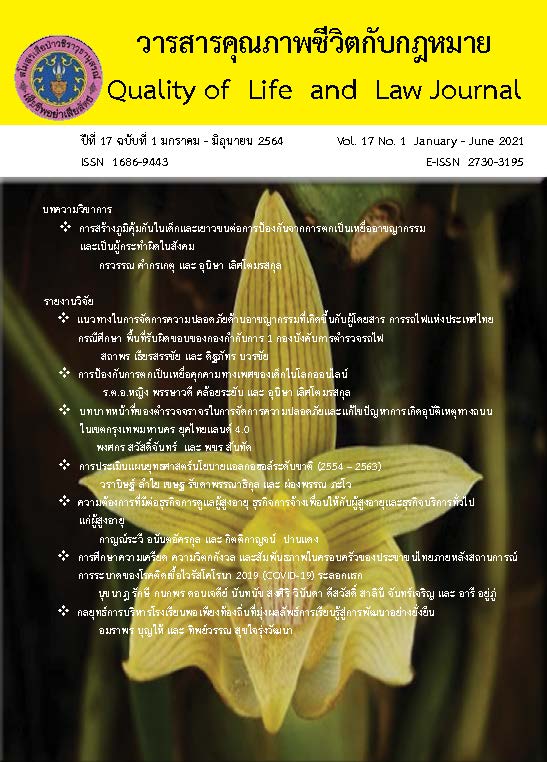The prevention of online child sexual crime victimization
Main Article Content
Abstract
This objectives were 1) to study the problem of online child sexual victimization. 2) To study the problems and barriers to preventing child sexual victimization online. 3) To provide advice on how to prevent child sexual victimization online. This study was a qualitative research utilizing in-depth interview technique. The 10 samples consisted of government organizations, private organizations and multidisciplinary teams.
The results of the research were as follows: The current problem of sexual harassment on social media is increasing. This is caused by various reasons, including the child's easy access to social media with no boundary of space and time. Besides, children themselves have different perceptions of the media and different self-awareness of the dander on the cyber space. Family problem is also one of the causes that turn children into social media dependence. Furthermore, the environment in which the child live in, peer influences and the experienced perpetrators are also the the factors of children’s being victimized on line. The patterns of online sexual harassment include: Bullying, Sexual intimidation, Preaching and sexual assault. For obstacles to preventing child sexual victimization online, the study found that even though sanction laws and government policies on the prevention of sexual harassment online are consistent and updating but taking the accused into justice for punishment is difficult. Due to the fact that collecting all necessary evidence from the cyber space is hard to achieve. In addition, lack of coordination between government agencies, the public sector and the private sector make the problem even worse. Therefore, based on the results of this study, the author proposes the guidelines for preventing child sexual victimization online as following: 1)government and related agencies should uptake proactive actions and more public relations,2) using social media as a channel to educate children, 3) the relevant government officials pay more attention to the case and the victim by not giving their information to the public and 4) the private organizations should take part in providing various resources to government agencies.
Regarding the recommendation from this study, it is clearly shown that the sexual harassment of children online takes many forms, therefore, parents, teachers and government officials including the private sector should collaborate in raising awareness of children on how to avoid being the victim of on-line sexual harassment and understand the danger of social media so that they can safeguard themselves from being the victim.
Article Details
- บทความหรือข้อคิดเห็นใดๆ ในวารสารคุณภาพชีวิตกับกฎหมายเป็
- กองบรรณาธิการไม่สงวนสิทธิ์
References
จิรศักดิ์ ภูมิเจริญ. (2563, 25 เมษายน). เอกสารประกอบการเรียนการสอนวิชา 400-13-01 เทคโนโลยีสารสนเทศบูรณาการ (integrated information technology). [ระบบออนไลน์]. http://lms.rmutsb.ac.th/elearning/claroline/document/document. php? cidReset=true&cidReq=4001301_003.
บารเมษฐ์ ดวงเพชร. (2559). การคุกคามทางสื่อออนไลน์ต่อนักศึกษาระดับอุดมศึกษาในจังหวัดเชียงใหม่. การค้นคว้าอิสระปริญญามหาบัณฑิต บัณฑิตวิทยาลัย มหาวิทยาลัยแม่โจ้.
เปรมฤดี บุญตามช่วย. (2550). การตกเป็นเหยื่อจากการถูกคุกคามทางอินเตอร์เน็ต : ศึกษากรณีผู้ใช้โปรแกรมการสนทนาทางอินเทอร์เน็ต. วิทยานิพนธ์ปริญญามหาบัณฑิต
มหาวิทยาลัยมหิดล.
ธวัชชัย แม่นศร. (2562). กลยุทธ์การนำเสนอสารของเฟซบุ๊กแฟนเพจบริษัททัวร์ชั้นนำของประเทศไทย. วิทยานิพนธ์ปริญญามหาบัณฑิต บัณฑิตวิทยาลัย มหาวิทยาลัยรามคำแหง.
รักข์ษิตา โพธิ์พิทักษ์กุล. (2550). มาตรการทางกฎหมายเกี่ยวกับการคุกคามทางอินเตอร์เน็ต. วิทยานิพนธ์ปริญญามหาบัณฑิต บัณฑิตวิทยาลัย มหาวิทยาลัยกรุงเทพ.
สำนักงานพัฒนาธุรกรรมทางอิเล็กทรอนิกส์ (องค์การมหาซน). (2562). รายงานผลการสำรวจพฤติกรรมผู้ใช้อินเทอร์เน็ตในประเทศไทย. กรุงเทพฯ: สำนักงานพัฒนาธุรกรรมทางอิเล็กทรอนิกส์
(องค์การมหาชน).
World internet users statistics. (2020, 24 March). Internet user in the world. [ระบบออนไลน์]. http://www.internetworldstats.com/stats.htm.


